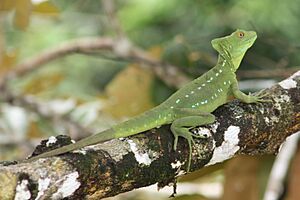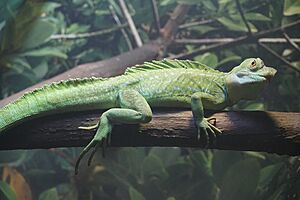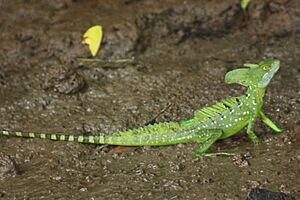Plumed basilisk facts for kids
Quick facts for kids Plumed basilisk |
|
|---|---|
 |
|
| Male, Alajuela Province, Costa Rica | |
 |
|
| Female plumed basilisk | |
| Conservation status | |
| Scientific classification | |
| Genus: |
Basiliscus
|
| Species: |
plumifrons
|
The plumed basilisk (Basiliscus plumifrons) is a cool lizard also known as the green basilisk or Jesus Christ lizard. It belongs to the family called Corytophanidae. This amazing creature lives naturally in Central America.
You can find the plumed basilisk from southern Mexico all the way to northern Colombia. It loves hot, wet rainforests that have streams, rivers, or other water nearby.
These lizards are very striking to look at! They are bright green with black and white stripes on their neck and back. Males and females look a bit different, which is called being sexually dimorphic. Males have a special crest on their back and tail, plus large plumes (like feathers) on their heads. Females usually have only one smaller crest on their head.
The green basilisk is famous for its unique ability to run across water! It does this super fast when it needs to escape from predators. Keeping up its speed helps it avoid sinking.
These lizards are also very territorial. This means a male basilisk will defend its space. Because of this, you usually can't keep many male basilisks together in a small area. However, in the wild, they can live in larger groups.
Contents
Where Plumed Basilisks Live
Plumed basilisks live in rainforests close to running streams. You can find them in southern Mexico and northern Colombia. They prefer wet, grown-up forests with streams, where it's usually hot and humid.
Even though they are native to Mexico and Colombia, some have been seen in other places. This includes areas from eastern Honduras to western Panama. They have also been spotted along the Pacific coast in southwestern Costa Rica.
Plumed basilisks are arboreal, which means they love living in trees. They are also diurnal, meaning they are active during the day. They are often found in trees or resting on rocks near water. This makes them unique because they are good at both climbing trees and being in water.
These lizards like temperatures around 31.7 degrees Celsius (about 89 degrees Fahrenheit).
What's in a Name?
The name Basiliscus comes from an old legend. It's about a mythical creature called a Basilisk that could turn people to stone with just a look! The name comes from the Greek word basilískos, which means "little king." Carl Linnaeus gave this name to the lizard.
The nickname "Jesus Christ lizard" comes from its amazing ability to run on water. You can read more about this in the "How They Behave" section below.
What Plumed Basilisks Look Like
The plumed basilisk is the biggest type of basilisk lizard. Its body, from snout to vent (the opening at the base of the tail), is about 10 inches (25 cm) long. If you include its tail, it can reach a total length of 3 feet (91 cm)!
Adult basilisks are bright green with bright yellow eyes. They also have small bluish spots along their back. Males have three crests: one on their head, one on their back, and one on their tail. Females only have a crest on their head. Young basilisks are not as brightly colored and don't have these crests yet.
The plumed basilisk has a triangular head when you look at it from the side. It has ear openings that are a bit bigger than its eyes. Their eyes are usually round with yellow centers. Their skin is covered in small, bumpy scales.
Their back legs are longer than their front legs. This is because their back legs are used for running on water. Their toes are also flat and angled sideways to help them with this special skill.
Who Hunts Plumed Basilisks?
The plumed basilisk has several predators. These include birds of prey (like hawks), opossums, coatis, and snakes.
How Plumed Basilisks Behave

Male plumed basilisks are very territorial. One male might protect an area where several females live, and he will mate with them. When kept as pets, these lizards don't like to be handled much.
The plumed basilisk can run short distances across water. It uses both its feet and tail to stay up. Other basilisk lizards and the Malaysian sail-finned lizard can do this too. When they run, they create a small air pocket under their feet. They use this to push themselves forward. Adult basilisks are heavier than young ones, so they can run across the water more easily to escape predators. This is why they are nicknamed the "Jesus Christ lizard." They are also excellent swimmers and can stay underwater for up to an hour!
Running on water is a special skill for the plumed basilisk. They use this behavior when they feel threatened by predators. This strategy is often used when they are scared or stressed. Plumed basilisks run on two legs (bipedally). They use their feet and lower legs to push into the water. This behavior can be better than diving or swimming for escaping predators in the water, like snakes or large fish.
How fast a plumed basilisk can run on water depends on how long its back legs can stretch. Longer hind legs allow for a bigger push and faster speed. The size of the lizard's foot also helps it gain speed. The plumed basilisk has toes that are angled in a special way, giving its foot a larger surface area to run across the water. Adult basilisks can run at about 2.14 meters per second (about 4.8 miles per hour) on water. Young basilisks run a bit slower. While other lizards can run on water, plumed basilisks are known for being very good at it and are less afraid to use this skill.
Running on Water: How it Works
Basilisk lizards are famous for running across water from the moment they are born. Both young and adult basilisks use this unique trick to avoid being caught by predators. They can do this because their back legs are long and they have webbing between their toes. This webbing traps small pockets of air, which helps the basilisk push off the water quickly.
Tiny insects can run on water because of surface tension (like a thin skin on the water). But basilisk lizards are much heavier. They run on water using different rules of fluid dynamics (how liquids move). The lizard pushes its back leg into the water, creating an air-filled space. Then it pulls its leg back before the space closes. This helps the basilisk touch the water as little as possible. This running style also reduces drag (resistance from the water) and helps the lizard move across the water at an average speed of 1.6 meters per second (about 3.6 miles per hour).
Even though all basilisk lizards can run on water, there are small differences in how they do it. These differences are mostly about how fast they run, not how heavy they are. This unique way of moving is special to basilisk lizards. For other lizards that live on land, their running styles are usually more similar. Studies have also shown that the basilisk's back legs are the main power source when they run on water.
The basilisk lizard's amazing ability to run on water has even inspired scientists. They are using what they learn from these lizards to try and build robots that can also run on water!
Reproduction and Life Cycle
Before laying eggs, female basilisks will show themselves to the male. The female will get close to the male, lower her front body, and raise her tail. Females lay between five and fifteen eggs at a time. They lay them in warm, damp sand or soil. One female lizard in captivity started digging holes (sometimes called nests) six months before laying eggs, long before the breeding season.
The eggs hatch after eight to ten weeks. The baby lizards that come out are fully independent. They are only about 43 millimeters (1.7 inches) long and weigh about 2 grams (0.07 ounces). Young male basilisks start to grow their large crests after six months or even more than a year. This depends on how healthy and big they are.
Female basilisks start to look "plump" one to two weeks after they become pregnant. In the third week, they begin to look for a place to dig a burrow and lay about 14 to 17 eggs. The number and size of the eggs can change depending on the mother's age, health, and size. It's common for female plumed basilisks to lay several groups of eggs in one season. This can happen up to four or five times during the breeding season. The eggs hatch over one or two days after being in the nest for eight to ten weeks.
What Plumed Basilisks Eat
Plumed basilisks are omnivores, meaning they eat both meat and plants. While they might not always eat meat in the wild, they enjoy a wide variety of insects and worms. They can eat plants like fruits, seeds, flowers, and leaves. However, they usually prefer insects in the wild, more so than in captivity.
They hunt smaller animals like fish, small mammals (like rodents), small birds, small non-poisonous snakes, smaller lizards, amphibians, and invertebrates (like freshwater shrimp, crayfish, and spiders). But they are most often looking for insects to eat.
They commonly eat brown crickets, black crickets, and locusts. When kept as pets, some owners feed their plumed basilisks wax worms, calciworms, cockroaches, mealworms, and beetle worms sometimes. However, these worms and beetles are not the best for their diet. They are high in fat and can be hard for young basilisks to digest.



